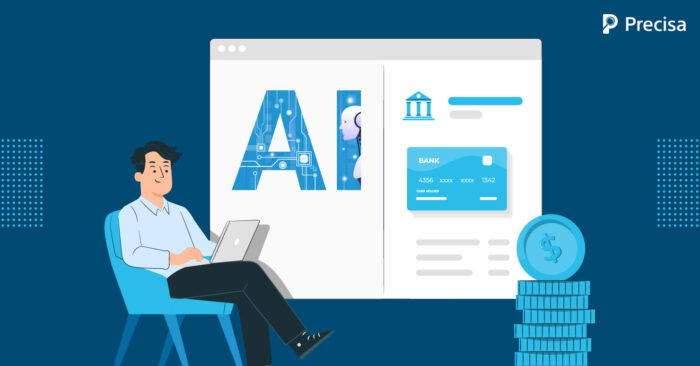AI in Banking: Why Financial Institutions are Betting Big on Artificial Intelligence?

AI in banking is redefining the financial sector and changing how banks function and interact with customers. Financial institutions are assessing options and adopting groundbreaking technology to meet the ever-evolving expectations of tech-savvy customers and meet emerging challenges like security, compliance and changing marking dynamics.
The convergence of banking, telecom, retail and information technology has expanded the transfer of information over virtual networks, making them vulnerable to online threats and frauds. Artificial Intelligence (AI), a fast-emerging technology, can help banks deal with these challenges, improve their decision-making, and manage risks better.
Studies reveal banks expect to save $447 billion by 2023 through AI applications.
Additionally, 85% of business executives viewed AI as essential for providing businesses with a sustainable competitive advantage.
This blog post focuses on how AI in banking will shape the future of the financial sector.
Emerging Use of AI in Banking

The data-driven nature of the banking industry provides the perfect space for artificial intelligence to grow and thrive. The banking industry has witnessed a remarkable transformation by leveraging Artificial Intelligence. Banks and financial institutions (FIs) are recognising AI’s potential and leveraging it in multiple arenas.
Now, let us look at the critical benefits of AI in banking.
Improved Customer Experience
Artificial intelligence improves banks’ understanding of customer behaviour based on past interactions and helps them customise financial products by adding personalised features.
Using AI in banking helps empower customers through chatbots, which can answer basic user questions 24/7, enabling customer access to help even outside of regular office hours. Chatbots also offer valuable input to customers to help them solve their problems on their own.
As per a survey, 68% of the customers found the speed of chatbots appealing.
Automating tasks like account opening and loan processing reduces the turnaround time and enhances customer satisfaction and loyalty.
Forecasting Future Trends
Banks can benefit from predictive analysis in fields like forecasting market trends, risk management and optimising investment decisions.
AI in banking helps predict future scenarios and outcomes based on analysis of past behaviour. Predictive analytics involves analysing data using statistical models and machine learning algorithms to identify patterns and predict future events.
Banks can identify probable fraud, detect patterns that point towards money laundering and make customer recommendations. AI can also help recognise dubious data patterns from enormous volumes of data with the power of Machine Learning for effective fraud management.
Based on past studies and analysis, artificial intelligence can help FIs up-sell and cross-sell products and explore untapped sales opportunities, thereby deepening and widening customer relations.
Reduce Costs
Artificial intelligence can help FIs reduce costs through automation, reducing errors and powering customer service. Automating repetitive, high-volume, and time-consuming work processes through software bots using an emerging technology called RPA (Robotic Process Automation) reduces the time and labour required to carry out these processes.
Automation also helps decrease human errors, which can have substantial financial implications. AI in banking enables the automation of several costly, information-intensive, and error-prone banking services.
AI algorithms help accurately and swiftly process services at each step and help FIs avoid human errors in routine tasks when processing a high volume of customer interactions.
AI-powered chatbots can offer customer services 24/7 and reduce costs associated with hiring, training and managing shifts of customer support staff.
Regulatory Compliance
The financial sector is highly regulated, and FIs have to adhere to the policies and guidelines laid down by the governments and various statutory bodies. FIs have internal compliance teams to ensure they function according to the specified guidelines and rules.
For example, using the Natural Language Processing (NLP) branch of AI offers many benefits in compliance. It can help in due diligence screening for Anti Money Laundering by analysing, identifying, and managing high volumes of data.
The compliance regulations change from time to time based on changing government regulations. Updating the processes and workflows and imparting the required training across departments is challenging and time-consuming.
Precisa’s Bank Financial Statement Analyser helps in regulatory compliance by pointing out infractions, anomalies, or attempted financial statement manipulation.
Risk Management
Financial institutions face credit and market risks, which can have significant implications. AI algorithms can help identify potential risks associated with specific borrowers or industries and help banks make better-informed decisions while minimising risks.
As per Juniper Research, the expenditure on financial fraud detection platforms that utilise AI is projected to surpass $10 billion globally by 2027.
AI technologies can analyse large volumes of data and identify irregularities that could lead to fraudulent activities.
External global factors like natural disasters, currency fluctuations, or political unrest impact the banking and financial industries. AI can help FIs through analytics that offer a clear picture of what is to come and help them stay prepared through timely decisions.
AI is also instrumental in identifying risky applicants by evaluating the probability of a borrower defaulting to pay their dues.
The Takeaway
AI in banking has been a disruptive force like so many emerging technologies. Artificial intelligence harnesses the power of advanced data analytics to improve customer services, decrease costs, manage risks better, reduce fraudulent transactions and improve compliance.
Precisa’s AI-driven Bank Statement Analyser assesses the customer’s financial health by analysing indicators such as income stability, cash flow, debt-to-income ratio and savings patterns. It also enables fraud detection by identifying suspicious transactions, including money laundering, fraudulent activities and potential risks.
Additionally, it seamlessly integrates with account aggregator platforms and allows banks to access consolidated financial data from multiple sources.
Sign up today for a free demo.



